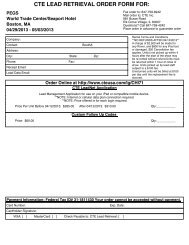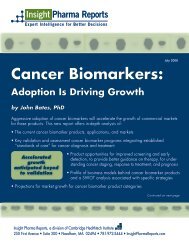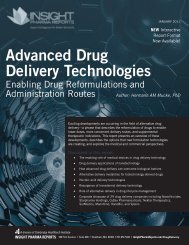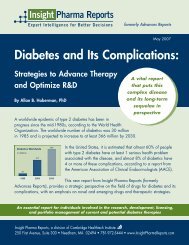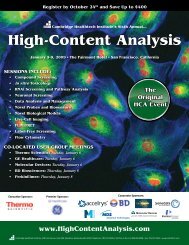2010 Best Practices Competition IT & Informatics HPC
IT Informatics - Cambridge Healthtech Institute
IT Informatics - Cambridge Healthtech Institute
- No tags were found...
Create successful ePaper yourself
Turn your PDF publications into a flip-book with our unique Google optimized e-Paper software.
Published Resources for the Life Sciences<br />
250 First Avenue, Suite 300, Needham, MA 02494 | phone: 781‐972‐5400 | fax: 781‐972‐5425<br />
Knowledge Management: Data mining, idea/expertise mining, text mining, collaboration,<br />
resource optimization<br />
Health‐<strong>IT</strong>: ePrescribing, RHIOs, EMR/PHR<br />
Manufacturing & Bioprocessing: Mass production, continuous manufacturing<br />
(Bio‐<strong>IT</strong> World reserves the right to re‐categorize submissions based on submission or in the event that<br />
a category is refined.)<br />
6. Description of project (4 FIGURES MAXIMUM):<br />
A. ABSTRACT/SUMMARY of the project and results (150 words max.)<br />
High-content screening (HCS) data has unique requirements that are not supported by<br />
traditional high-throughput screening databases. Effective analysis and interpretation of<br />
the screen data requires ability to designate separate positive and negative controls for<br />
different measurements in multiplexed assays.<br />
The fundamental requirements are the ability to capture information on the cell lines,<br />
fluorescent reagents and treatments in each assay; the ability to store and utilize<br />
individual-cell and image data; and the ability to support HCS readers and software from<br />
multiple vendors along with third-party image analysis tools. The system supports target<br />
identification, lead discovery, lead evaluation and lead profiling activities.<br />
The solution was designed using a combination of complimentary technologies that later<br />
became part of best practices at Bristol-Myers Squibb’s Research <strong>Informatics</strong>. The image<br />
data generated by HCS processes is over 50 TB over five years and has seen exponential<br />
growth trends. Database and data logistics were built using Oracle (11g) partitioning<br />
techniques, Isilon storage was used to handle unstructured data and EMC for relational<br />
data. Application was built using techniques like external tables, caching, materialized<br />
views, parallel queries and used .Net framework for business rules and visualizations.<br />
Statistical functions in Oracle API libraries were leveraged for analysis.<br />
INTRODUCTION/background/objectives<br />
High content screening (HCS) has demonstrated utility at multiple points in the drug<br />
discovery process including target identification, target validation, lead identification, lead<br />
evaluation and profiling 1 , mechanism of action determination 2 and toxicology<br />
assessment 3 . Within a single organization, HCS may be used for multiple purposes with<br />
distinct groups and even instruments supporting different stages of drug discovery. The



